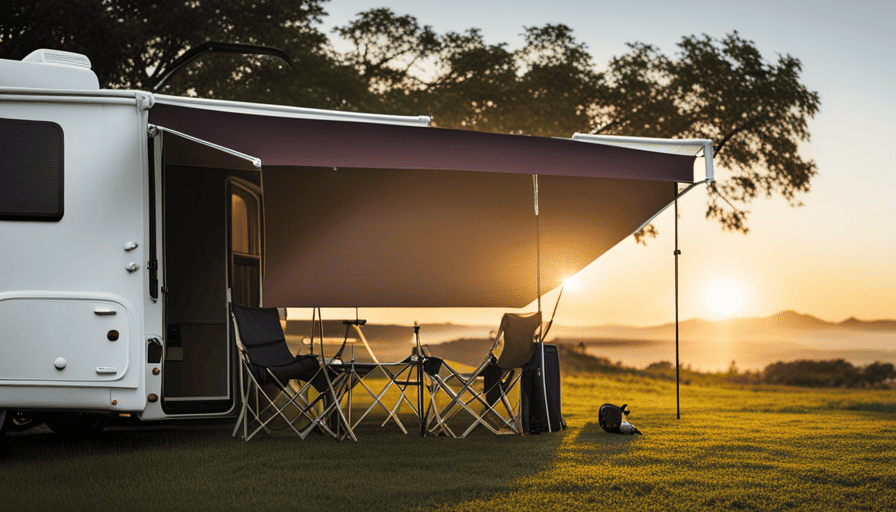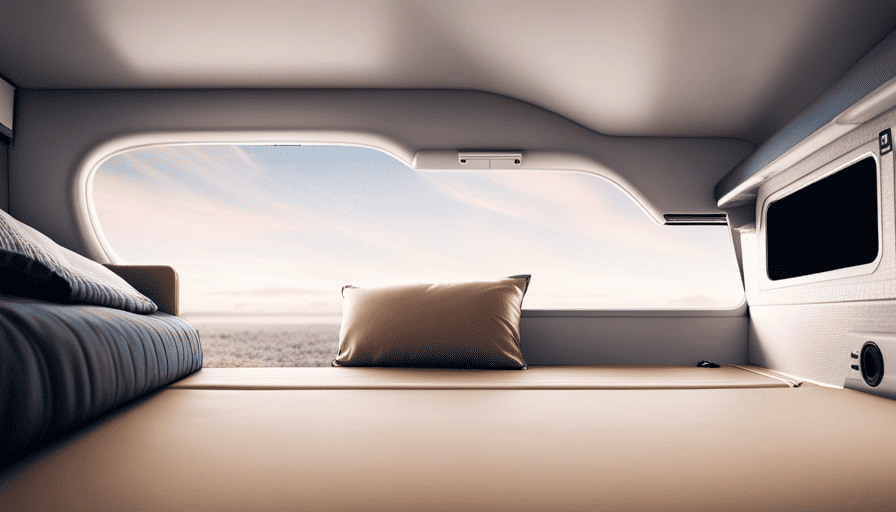Picture yourself relaxing outside your RV on a beautiful, sunny day, enjoying the breathtaking views all around you. The only thing missing is some shade to keep you cool and comfortable. That’s where a camper awning comes in.
Installing a camper awning is like adding a little slice of heaven to your outdoor adventures. It provides shade, protection from the elements, and a cozy space to relax and unwind.
In this article, I will guide you through the step-by-step process of installing a camper awning. From gathering the necessary tools and materials to securing the awning in place, I will share my knowledge and practical tips to ensure a successful installation.
So, grab your toolbox and let’s get started on transforming your camper into the ultimate outdoor oasis!
Key Takeaways
- Choosing the right awning is crucial, considering factors such as fabric durability, mechanism, size, and style.
- Properly measuring and preparing the installation area ensures a smooth installation process.
- Installing awning mounting brackets correctly is essential for the stability and functionality of the awning.
- Regularly maintaining and inspecting the awning helps extend its lifespan and ensures it provides shade and protection effectively.
Gather the Necessary Tools and Materials
Now, you’re going to need a few tools and materials to get started with installing your camper awning. First and foremost, it’s important to choose the right materials for the job. Look for a high-quality awning that’s specifically designed for campers, as it’ll be more durable and weather-resistant.
Additionally, gather a tape measure, a level, a drill with various drill bits, screws, a screwdriver, and a ladder. These tools will ensure that your installation goes smoothly and that your awning is securely attached to your camper.
Once you have all the necessary tools, it’s time to prepare the installation area. Start by finding a suitable location on your camper where the awning can be mounted. Make sure there’s enough space and that it won’t interfere with any existing fixtures or accessories. Clean the area thoroughly to remove any dirt or debris that could affect the installation process.
With the tools and materials gathered, and the installation area prepared, you’re now ready to move on to the next step: choosing the right awning for your camper. This is an important decision that’ll depend on your personal preferences and the specific requirements of your camper.
Choose the Right Awning for Your Camper
First off, let’s talk about finding the perfect shady companion for your outdoor adventures. When choosing the right awning for your camper, there are a few key factors to consider.
-
Fabric: The fabric you choose for your awning is crucial as it determines its durability and resistance to weather conditions. Look for fabrics that are UV-resistant, waterproof, and easy to clean.
-
Mechanism: Understanding the different types of awning mechanisms is important to ensure easy installation and operation. There are manual awnings that require manual cranking, and there are also electric awnings that can be operated with a push of a button. Choose the mechanism that suits your needs and preferences.
-
Size: Consider the size of your camper and the space you want to cover with the awning. Measure the area where you plan to install the awning to ensure a proper fit.
-
Style: Lastly, think about the overall style and design of your camper. Choose an awning that complements the aesthetics of your camper and adds to its overall appeal.
Now that you’ve chosen the perfect awning for your camper, let’s move on to the next step: measuring and preparing the installation area.
Measure and Prepare the Installation Area
When it comes to setting up your shady oasis, the first step is to carefully measure and prepare the area where you want to mount your new outdoor companion. Before you start, gather your measuring tools such as a tape measure and level.
Begin by measuring the width of your camper from one side to the other, ensuring that you have enough space for the awning to extend fully. Next, measure the height from the ground to the desired mounting point to ensure that the awning will provide adequate shade.
Once you have these measurements, it’s time to prepare the installation area. Clear away any debris or obstacles that may hinder the installation process. Make sure the surface is clean and level, as this will ensure a secure and stable mounting for your awning.
With the area measured and prepared, you are now ready to install the awning mounting brackets. These brackets will securely hold your awning in place and allow for easy extension and retraction.
Install the Awning Mounting Brackets
To securely attach your new outdoor companion, you’ll need to mount the awning brackets. These brackets are essential for ensuring stability and allowing for easy extension and retraction of your camper awning. Imagine the awning brackets acting as the strong foundation that holds up your shaded oasis, just like how a strong base supports a towering structure.
Installing the awning brackets is a straightforward process that requires a few basic tools. First, gather a drill, screws, and a measuring tape. Start by positioning the brackets at the desired height and marking the mounting holes with a pencil. Make sure to align the brackets evenly on both sides of the camper.
Once you have marked the holes, use the drill to create pilot holes for the screws. This step will prevent the brackets from shifting or coming loose over time.
Next, secure the awning brackets to the camper by driving the screws through the pilot holes. Ensure that the brackets are tightly fastened to provide maximum support.
Once the brackets are securely in place, you can move on to the next step of attaching the awning fabric to the mounting brackets.
Now that the awning brackets are securely installed, it’s time to attach the awning fabric to them.
[Transition to the next section: ‘To attach the awning fabric, follow these simple steps.’]Attach the Awning Fabric to the Mounting Brackets
Now that your outdoor oasis is secured in place, let’s dive into the exciting process of connecting the vibrant awning fabric to the sturdy mounting brackets. Attaching the fabric is a crucial step in installing your camper awning as it ensures not only its stability but also its functionality.
To begin, locate the designated slots on the awning fabric and align them with the corresponding holes on the mounting brackets. Gently slide the fabric into the brackets, making sure it fits snugly. Once the fabric is in place, secure it using the provided screws or bolts. Ensure that the fabric is evenly distributed along the length of the brackets to maintain a balanced appearance.
Installing the brackets and attaching the fabric are the foundation of a successful camper awning installation. With these steps completed, you’re now ready to adjust the awning tension and position. This next phase will allow you to customize the awning to suit your preferences, providing the perfect amount of shade and protection.
So, let’s move on to the exciting part of fine-tuning your camper awning and creating your ideal outdoor space.
Adjust the Awning Tension and Position
Once you’ve attached the fabric, you can easily adjust the tension and position of your awning to create the perfect outdoor oasis. Adjusting the awning tension is a crucial step in ensuring its stability and functionality. To do this, locate the tension knobs or screws on the awning arms. Turning these knobs or screws clockwise will increase the tension and make the awning fabric tighter. Conversely, turning them counterclockwise will loosen the tension and allow the fabric to sag. It’s important to find the right balance, as excessive tension can damage the awning while insufficient tension may cause the fabric to flap in the wind.
Troubleshooting common awning problems is also essential for optimal performance. If the awning is not extending or retracting properly, check for any obstructions or debris that may be hindering its movement. Additionally, inspect the awning arms and brackets for any signs of damage or wear. If you notice any issues, consult the manufacturer’s instructions or seek professional assistance to resolve them.
With the tension properly adjusted and any potential problems addressed, it’s time to test the awning for proper operation.
Test the Awning for Proper Operation
Make sure everything is in place and give it a try to see how smoothly your outdoor retreat unfolds.
Testing the awning for proper operation is an important step to ensure that it functions correctly and provides the desired shade and protection. Start by extending the awning fully and checking if it opens and closes smoothly. Pay attention to any jerky movements or resistance, as these could indicate a problem that needs to be addressed.
Next, test the tension of the awning by gently pushing up on the fabric. It should have a slight give but not sag excessively. If the tension is too loose or too tight, consult the manufacturer’s instructions for adjusting it.
Additionally, check if the awning is level and properly aligned with the camper. If it is not, follow the troubleshooting steps provided by the manufacturer to correct the issue.
Once you have tested the awning and ensured its proper operation, you can move on to securing it in place for a worry-free camping experience.
Secure the Awning in Place
To ensure a worry-free camping experience, be sure to firmly secure your awning in place. Regular maintenance for camper awnings is of utmost importance to prolong their lifespan and ensure their proper functioning.
When it comes to securing the awning during strong winds, here are a few tips to keep in mind.
Firstly, always check the manufacturer’s guidelines for specific instructions on securing your awning. They may provide additional recommendations based on the design and features of your particular awning. Generally, though, it’s essential to use sturdy stakes or anchors to secure the awning to the ground. Make sure they’re driven deep enough into the soil to provide sufficient stability.
Additionally, consider using tension straps or ratchets to further secure the awning to the camper or nearby structures. This’ll help prevent any flapping or movement that could potentially damage the awning during windy conditions.
Lastly, it’s crucial to periodically inspect the awning and its securing mechanisms for any signs of wear, damage, or loosening. Address any issues promptly to prevent further damage and ensure the awning remains secure during your camping trips.
By following these tips, you can have peace of mind knowing that your awning is securely in place, even during strong winds. This’ll allow you to fully enjoy your camping experience without worrying about the awning coming loose.
In the next section, we’ll discuss how to maintain and care for your camper awning, ensuring its longevity and continued functionality.
Maintain and Care for Your Camper Awning
Now that you’ve securely installed your camper awning, it’s important to know how to properly maintain and care for it. By following these simple steps, you can ensure that your awning remains in great condition for years to come.
First and foremost, it’s crucial to regularly clean the awning fabric to prevent dirt and debris from accumulating. You can do this by gently scrubbing the fabric with a mild soap and water solution, taking care to remove any stains or spots.
Additionally, it’s recommended to regularly inspect the awning hardware for any signs of wear or damage. This includes checking the screws, brackets, and hinges to ensure they’re tight and in good working condition.
To evoke a sense of pride and satisfaction in your audience, here are three sub-lists of emotional benefits you can experience by properly maintaining your camper awning:
-
Peace of mind: Knowing that your awning is well-maintained gives you peace of mind, allowing you to fully enjoy your camping experience without worrying about any potential issues.
-
Longevity: Regular maintenance can significantly extend the lifespan of your awning, saving you money in the long run by avoiding costly repairs or replacements.
-
Aesthetics: Cleaning and caring for your awning can enhance the overall appearance of your camper, making it look clean, well-maintained, and inviting.
By properly maintaining your camper awning and regularly cleaning the fabric and hardware, you can enjoy the benefits of your new camper awning for many years to come.
Enjoy the Benefits of Your New Camper Awning
Experience the incredible advantages of your brand new camper awning and revel in the added comfort and enjoyment it brings to your outdoor adventures. Your new camper awning isn’t just a practical addition to your vehicle, but a gateway to enjoying nature and outdoor relaxation like never before.
With your new camper awning, you now have a comfortable and shaded space where you can relax and unwind after a long day of exploring the great outdoors. Whether you’re camping in the mountains or by the beach, your awning provides a cozy spot to sit back and take in the breathtaking views around you.
Imagine sitting under your awning, sipping a hot cup of coffee in the morning as you watch the sun rise over the horizon. Or perhaps enjoying a delicious meal with your loved ones, protected from the elements, while still feeling connected to nature. Your camper awning creates a sense of intimacy with the outdoor environment, allowing you to fully immerse yourself in the beauty that surrounds you.
Outdoor relaxation becomes a whole new experience with your camper awning. You can now read a book, play games, or simply take a nap in the comfort of your shaded oasis. No longer do you have to worry about the scorching sun or unexpected rain ruining your outdoor plans. Your awning provides the perfect shelter, allowing you to enjoy the outdoors in any weather condition.
So, embrace the benefits of your new camper awning and make the most of your outdoor adventures. Experience the joy of enjoying nature and outdoor relaxation in a whole new way.
Frequently Asked Questions
How long does it typically take to install a camper awning?
On average, the installation of a camper awning can take anywhere from 1 to 2 hours. However, the actual time may vary depending on the individual’s experience and the complexity of the awning system.
The installation difficulty can range from easy to moderate, depending on the specific type of awning and the tools required. It’s important to carefully follow the manufacturer’s instructions and take necessary safety precautions during the installation process.
Can I install a camper awning on my own, or do I need professional help?
Installing a camper awning can be done either as a DIY project or with the help of a professional. It ultimately depends on your level of experience, time availability, and comfort with tools. If you have prior knowledge and feel confident in your abilities, a DIY installation can save you money.
However, if you’re unsure or want to ensure a seamless installation, professional help is recommended. They have the expertise and tools to guarantee a secure and efficient installation.
What is the average cost of installing a camper awning?
The average cost of installing a camper awning can vary depending on various factors such as the size of the awning, the type of material used, and the complexity of the installation. On average, you can expect to spend around $500 to $1500 for a professional installation.
The installation time can also vary, but typically it takes a few hours to a full day to complete the installation. It’s always best to consult with a professional to get an accurate estimate for your specific camper awning installation.
Can I install a camper awning on a camper with a curved roof?
Installing a camper awning on a camper with a curved roof can be a bit more challenging, but it’s definitely possible. To find the right awning for a camper with a curved roof, it’s important to look for models specifically designed for curved roofs. These awnings will have adjustable arms or a flexible design to accommodate the curve. Once you have the right awning, follow the manufacturer’s instructions for installation. Make sure to secure it properly to ensure stability and durability.
Are there any special considerations or precautions I should take when installing a camper awning on a fiberglass camper?
When installing a camper awning on a fiberglass camper, there are a few important considerations to keep in mind. Firstly, fiberglass camper maintenance is crucial to ensure the longevity of the awning. Regularly inspecting and cleaning the fiberglass surface will prevent any damage from occurring.
Secondly, it’s essential to choose the right size awning that fits your camper’s dimensions properly. This will ensure a secure and stable installation. Taking these precautions will guarantee a successful and hassle-free awning installation on your fiberglass camper.
Are the Steps to Install a Camper Awning the Same for All Campers?
When it comes to installing a camper awning, the steps can vary depending on the type of camper. Different campers may have specific guidelines and requirements. Before proceeding, it is crucial to carefully read the instructions provided by the manufacturer. Proper installation ensures a secure and functional awning, enhancing your camping experience.
Conclusion
As I stand back and admire my newly installed camper awning, I can’t help but feel a sense of accomplishment. It’s like adding the final brushstrokes to a masterpiece, transforming my camper into a cozy oasis.
The process of installation may have seemed daunting at first, but with the right tools, measurements, and a little patience, it all came together beautifully.
Now, as I lounge under the shade of my awning, I can’t help but feel a renewed sense of adventure, ready to embark on new journeys with the comfort and convenience this awning provides.
Happy camping!










